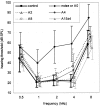Long memory in song learning by zebra finches
- PMID: 12890787
- PMCID: PMC6740713
- DOI: 10.1523/JNEUROSCI.23-17-06928.2003
Long memory in song learning by zebra finches
Abstract
Young songbirds use memorized tutor songs as templates to shape their own songs. This process requires control of voice by auditory feedback. We prevented zebra finches from hearing their own vocalizations by exposure to loud noise after 35 d of age, before which they had been reared with song tutors from birth. When the noise stopped at 102-200 d of age, the birds sang unstable and noisy song syllables that did not resemble the tutor syllables. The similarity to the tutor syllables steadily increased until the time of song crystallization approximately 30 d later. These findings show that the memory of tutor syllables survives auditory perturbations during the period when it is normally recalled and that zebra finches can use the memory well after the normal period of song development. The temporal order of syllables resembled the tutor model only in birds released from the noise before 80 d of age but not in older birds. Thus, different schedules and processes may govern the learning of syllable phonology and syntax.
Figures






References
-
- Aamodt SM, Kozlowski MR, Nordeen EJ, Nordeen KW ( 1992) Distribution and developmental change in [3H]MK-801 binding within zebra finch song nuclei. J Neurobiol 23: 997-1005. - PubMed
-
- Aamodt SM, Nordeen EJ, Nordeen KW ( 1995) Early isolation from conspecific song does not affect the normal developmental decline of N-methyl-d-aspartate receptor binding in an avian song nucleus. J Neurobiol 27: 76-84. - PubMed
-
- Baddeley AD, Thompson N, Buchanan M ( 1975) Word length and the structure of short-term memory. J Verbal Learn Verbal Behav 14: 575-589.
-
- Böhner J ( 1990) Early acquisition of song in the zebra finch, Taeniopygia guttata. Anim Behav 39: 369-374.
Publication types
MeSH terms
Grants and funding
LinkOut - more resources
Full Text Sources
Medical
